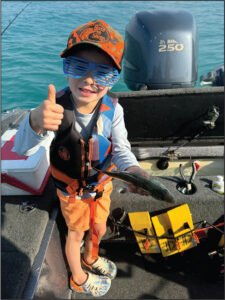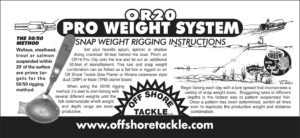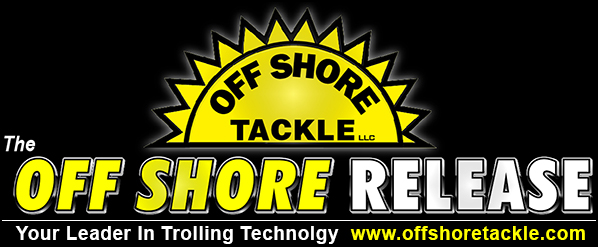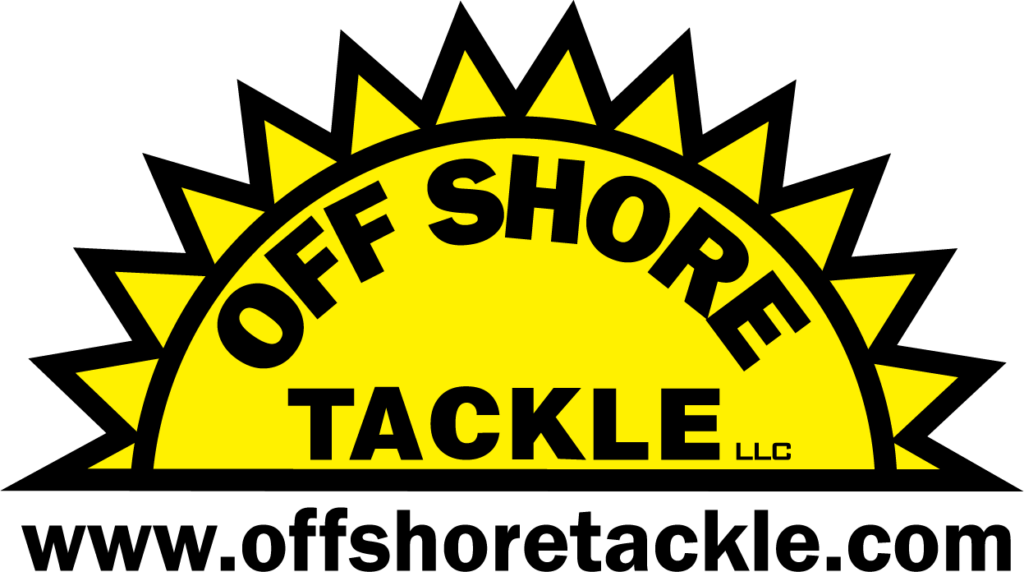BY MARK ROMANACK
It’s safe to say that Off Shore Snap Weights (the combination of an OR20 series weight attached via a split ring to an OR16 clip) were a game changer when they were first introduced in the early 1990’s. At the time, the only other in-line weights on the market were designed to be attached near the lure. Snap Weights were the first in-line trolling weights designed to be mounted anywhere on the fishing line!

personal fishing with his son, Everett, to target walleye and other species.
The early Snap Weights were sold as a kit (OR20) that featured an assortment of 1/2, 3/4, 1, 1.5, 2 and 3 ounce lead sinkers along with four OR16 clips and split rings. Not long after Snap Weights were introduced, Off Shore Tackle upgraded to molded zinc Guppy Weights, an environmentally friendly metal which also allows for a more consistent weight.
The ability to let your lure out 10, 20, 30, 40, 50 feet or more before attaching the Snap Weight created the first “stealth trolling” scenario. Separating the weight from the bait works wonders in triggering strikes, especially when fishing in clear waters or when targeting spooky fish species.
Snap Weights attach to the line thanks to another unique invention, the OR16 Pro Clip. At first glance the OR16 (red) appears to be an ordinary planer board line clip, but upon closer inspection, when the jaws are opened there is a small plastic pin located in the middle of the rubber jaw pads. When the OR16 is pinched open and the fishing line placed behind this pin, the Snap Weight is firmly attached to the line.
Snap Weights were designed at a time before super lines hit the market. The rubber pads in the OR16 work flawlessly with monofilament, fluorocarbon and copolymer lines. If super braids or fused lines are used with Snap Weights, it’s recommended to place the line behind the pin that protrudes through the center of the pads and then wrap the line one loop around the jaw. This simple step prevents the slippery super line from sliding and damaging the rubber pads and/or center pin of the OR16.
THE 50/50 METHOD
Because no one had used Snap Weights, it became necessary to provide anglers some user suggestions. The 50/50 METHOD was created by Precision Trolling Data as a means of helping anglers understand how deep Snap Weights would run when the various weight sizes were used, and common trolling speeds employed.
A chart was created that appeared in the early Precision Trolling Data books. This simple to use system consisted of letting your lure out 50 feet, attaching the Snap Weight of the desired size on the line and then letting out an additional 50 feet of line. At this point the rig could be fished as a flat line or attached to a planer board and sent out to the side of the boat.
The 50/50 Method became so popular countless anglers today still rig and fish their Snap Weights using this simple, but effective trolling setup.
MODERN SNAP WEIGHT DATA
As the use of Snap Weights evolved and more and more anglers began using them, it became obvious that a more versatile method of using Snap Weights for controlled depth fishing was needed. Again, Precision Trolling Data stepped up and created a whole new level of Snap Weight trolling data for the PTD phone app.
In the PTD app under the Off Shore Tackle menu, five sizes of the Snap Weight appear. This data is based on the running depth of the Snap Weight, not the trailing lure. This decision was made because anglers use Snap Weights to troll such a wide variety of baits including crawler harnesses, in-line spinners, trolling spoons and shallow diving crankbaits. It was determined that the lead length from the lure to the Snap Weight isn’t as important as the lead length from the Snap Weight to the rod tip.
This trolling strategy allows anglers to pick any lead length they want from the lure to the Snap Weight. Once the Snap Weight is placed on the line, simply zero out the line counter and let the Snap Weight back the desired “feet back” distance to achieve the desired “feet down” number. The data in the PTD app is based on a 1.5 MPH speed option.
THE 50+2 DATA
The next step in the evolution of fishing Snap Weights was to create a trolling system for fishing diving crankbaits in combination with Snap Weights. Once again Precision Trolling Data stepped up and created the 50+2 Data a trolling system that provides incredibly accurate diving depth data for a host of popular crankbaits.
The 50+2 Data method requires following a rigid set of requirements. First select the desired diving crankbait and open that page in the app. Touch the “line type” option to see if the 50+2 Data is available for that particular lure. If the lure is offered with 50+2 Data, choose that option and let the lure out behind the boat 50 feet.
Next place an Off Shore Tackle OR20 Series two ounce Guppy rigged Snap Weight on the line. Now go to the “feet down” picker wheel on the app and dial up the desired running depth. Now move to the “MPH” picker wheel and select the desired trolling speed.
At this point the app will kick out the “feet back” or overall trolling lead including the 50 foot initial lead required to reach that target depth. The 50+2 Data is incredibly accurate and allows anglers to not only fish deeper, but also to use shorter overall lead lengths.
 BASED ON 10# MONOFILAMENT
BASED ON 10# MONOFILAMENT
The 50+2 Data is based on 10# test or .014 diameter line diameter. If other line diameters or types are used anglers have some options to consider. If fluorocarbon, copolymer, fused and even super braid lines at or very close to .014 in diameter are used, the 50+2 Data will be nearly identical.
If significantly thinner in diameter lines are used, the bait will of course run deeper. If significantly thicker line diameters are used, the bait will of course not run as deep.
MORE THOUGHTS
It’s important to note that Snap Weights are most efficient when trolled at relatively slow trolling speeds of 2.0 MPH or below. When faster trolling speeds are employed, friction formed from the Snap Weight passing through the water, significantly impedes the ability for these in-line weights to achieve significant diving depth.
This becomes abundantly obvious if you study the 50+2 Data and compare the slow speeds to the faster speed options. Speed is the enemy of Snap Weights as they simply don’t perform as well as trolling speed and friction on the line is ramped up.
FINAL THOUGHTS
Snap Weights were the first in-line trolling weight that could be placed anywhere on the fishing line. Today there are a lot of copy cats out there, but nothing on the market functions better, is in wider use or is more trusted than the original Off Shore Tackle Snap Weight.
Today anglers can buy Snap Weights in a kit called the OR20 Pro Weight System or they can buy OR16 Pro Clips that come with split rings separately. The Guppy Weights are also sold separately making it easy to customize your own Snap Weight kit.


